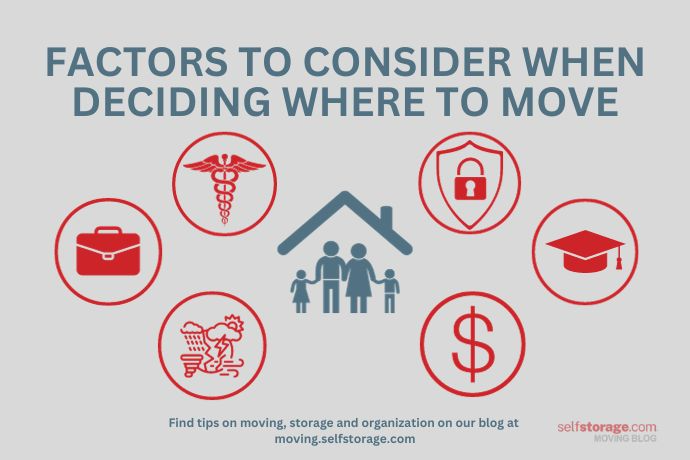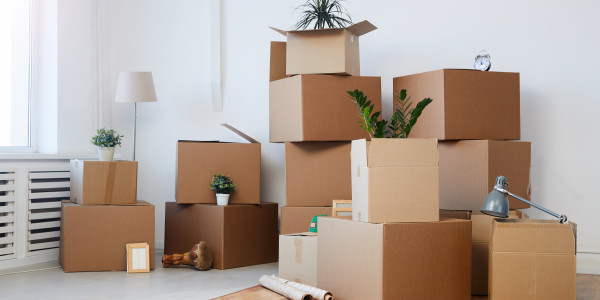What’s covered in this article – click on a link to learn more:
- Housing options
- Cost of living
- Job opportunities
- Local economy
- Education and child care
- Healthcare
- Weather
- Transportation
- Culture and social aspects
- Safety and security
- Quality of life
Moving to a new neighborhood is an exciting yet significant life decision. Whether it’s a local move within your city or a relocation to an entirely new area, choosing the right neighborhood involves careful consideration of various factors. Beyond just the physical aspects of housing, there are economic, social, and quality of life aspects that can greatly influence your overall experience. In this blog post, we’ll walk you through the essential considerations to keep in mind when deciding on your new neighborhood.
What Are My Housing Options?
The first step in finding the perfect neighborhood is to explore the housing options available. Are you looking for an apartment, a townhouse, or a single-family home? Consider factors such as property size, layout, and amenities. Are there nearby parks, shopping centers, and entertainment options that align with your lifestyle? It’s important to evaluate both the type of housing and the surrounding environment when deciding where to move.
To thoroughly vet a potential neighborhood, you want to consider things like safety, walkability, entertainment and attractions, etc. If you’re working with a real estate agent, they may be able to answer a lot of questions about the housing market and choices, but your agent can’t answer everything. U.S. News & World Report offers the following tips to gather information about a neighborhood before you move there:
- Visit at different times of day: The weekdays are likely to look different than a weekend. Traffic may pick up at times you aren’t expecting. Are people outside walking, running or biking after dark? That may be a sign that they feel safe in the neighborhood.
- Talk with neighbors: Neighbors don’t have an incentive to tell you anything but the truth – good or bad! Ask what they like and dislike about the area and be prepared for honest opinions.
- Consider how close area entertainment options are: If you love the idea of being able to walk to restaurants, coffee shops and stores, it’s a good idea to test “drive” the proximity of local businesses. Is it possible to get around on foot or will you have a large dependence on your car?
- Check out online resources: For questions that can’t be answered by visiting your future neighborhood in person, the following information websites below can help fill in the gaps.
Calculate the True Cost of Living
Understanding the cost of living in a new neighborhood is crucial for your financial well-being and may be one of the most significant factors to consider when moving. Does this area have an affordable cost of living? Research the average costs of housing, utilities, groceries, transportation, and other daily expenses. Ask yourself these questions to gauge whether you can truly afford to live in a more expensive place.
- Will you buy or rent a home? Pro tip: Renting a home for a predetermined amount of time may give you a better sense of what it would be like to live – and pay expenses – in a new neighborhood before you make a permanent move.
- Does this state or location of the country experience wild temperatures or extreme seasons? If so, heating and air conditioning expenses could vary widely.
- Is this one of the seven U.S. states that has no income tax? Consider your new tax liability.
- Will your job require you to commute daily? How far? Factor in how much you’d pay in gas.
- If you have kids and need childcare, are there affordable options in this area?
- How much more expensive would groceries be here?
Compare these costs with your current budget to ensure that you can comfortably afford the new area without compromising your financial stability. CNN Money has a cost of living calculator that can be a helpful tool in assessing your overall financial portrait before you move.
Assess the Job Opportunities in a New City
For many individuals and families, career prospects and employment opportunities play a pivotal role in choosing not only a new neighborhood but an entirely new city or state. Research the local job market in your field and explore the industries that thrive in the area. Proximity to potential employers can save you time and money on commuting while enhancing your work-life balance.
Another thing to consider is what you would do in the instance where you need a plan B because the first job doesn’t work out. How likely would you be to get another similar job in this new city? Are the jobs only location-dependent, meaning you have to be in a specific area in order to land another role there.
Indeed says the factors you should consider before relocating for a job opportunity include career growth, personal satisfaction, opportunity for advancing within the company, valuable location, salary and benefits, the cost of moving, the effect on personal relationships and whether the company might offer other options besides relocating.
What Does the Local Economy Look Like?
A neighborhood’s economic growth and stability can significantly impact its overall appeal. Look into the local economy’s growth trends, unemployment rates, and diversity of industries. A stable economy often leads to a thriving community with better services and amenities.
Is the unemployment rate high or low in this area? What is planned for the long-term trajectory of this city? The economic health of your new city will eventually impact your own financial well-being so it’s best to know what you’re up against before you decide to move.
The Value of Quality Education and Child Care is Clear
If you have children or plan to start a family, the quality of education and availability of child care services will be paramount. Even if you don’t have children, knowing the local education system affects you, too. Here’s why: The Federal Reserve Bank of St. Louis Review reports that home values usually increase at a steady clip in areas with good school districts. And sometimes sell for as much as 25 to 50 percent more than neighborhoods with lower quality schools.
Research the schools in the area, their ratings, extracurricular offerings, and any special programs they might have. Nonprofit websites like GreatSchools and SchoolDigger can give you a head start on researching educational institutions and child-friendly amenities. Additionally, explore the availability of reliable child care options for younger children.
Does This Neighborhood Have High-Quality Healthcare Facilities?
Access to healthcare facilities is crucial for your well-being, especially for retirees, people who have chronic health conditions or those with young children. If you or your family falls into one of those categories, where you end up moving may require you to be near hospitals with specialized care. Proximity to medical care can be especially important in emergencies.
The size of the city or town may greatly affect the availability and quality of healthcare services and facilities, hospitals, clinics, and medical professionals in the vicinity.
Pro tip: The Department of Health and Human Services has a guide for choosing the right hospital. The checklist contains the following steps:
- Learn about the care you need and your hospital choices, which you can accomplish by talking with your doctors or health care providers.
- Think about your personal and financial needs, which means examining your insurance coverage and narrowing down your preferences.
- Find and compare hospitals based on your condition and needs. You can also search online to compare the quality of hospitals you are considering. Some states have laws that require hospitals to report data about the quality and cost of their care.
- Discuss your hospital options with family members or friends, and choose a hospital.
Climate and Weather is a Quality of Life Consideration
The climate and weather patterns of a new neighborhood can have a profound impact on your lifestyle. Consider your preferences for temperature, seasonal changes, and weather patterns. Some people thrive in a warm climate, while others enjoy the distinct experiences that each season brings. If you enjoy winter sports, make sure the area you plan to move has them available – or at least where it’s possible. You may save money in areas where there typically aren’t wild temperature swings or extreme natural disasters.
As part of your research, look for average highs and lows, yearly precipitation patterns, the average number of sunny days, and whether you’re likely to experience all four seasons. Climate can impact everything from your physical comfort, mental health, and hobbies as well as employment options and the local economy.
Not All Cities Are Equal With Transportation Options
A well-connected neighborhood can save you time and stress on your daily journeys. Working from home is here to stay – and so is commuting to high-cost metropolises thanks to the explosive growth of suburban areas with affordable housing. Assessing transportation options is vital, especially if you rely on public transit or plan to commute to work. Check the availability and reliability of public transportation and commuting options, as well as the convenience of major highways and roads.
If congested roadways are your idea of a personal hell, you might want to avoid the U.S. cities with the worst traffic and longest commute times. See where your new city ranks with the INRIX Global Traffic Scorecard. Is walking your preference? Walk Score can give you a sense of how easy it would be to get around by foot in your new digs.
Does This City Have the Culture and Social Aspects You Want?
Every neighborhood has a unique cultural vibe and social scene. Does the one you’re considering have the vibe that you want? Generally speaking, larger cities may have more to choose from and built-in social networking opportunities while smaller cities may offer more of a laid-back, intimate charm among its residents. Ask yourself the following questions:
- How do you like to spend your leisure time?
- Do you want access to museums, professional sports teams, restaurants, and shops?
- Or do you prefer nature hikes, trails, and parks?
- If friends and family won’t be nearby, how do you plan to meet people?
- How easy does it appear to make connections and develop a new circle of friends?
Research local community events, cultural attractions, and recreational opportunities. Consider whether the neighborhood’s cultural activities and events align with your interests and hobbies.
Pro tip: Dig into whether your college or university has a strong alumni base in this new city. And if you can, take a trip to visit the new place to check it out in person, and get a feel for whether it offers the fresh perspective you’re looking for.
Would You Be Sacrificing Safety and Security?
All the job opportunities, sunny days, and cultural attractions mean nothing if you can’t feel safe in your new neighborhood. Even though a larger city (and thus population) is bound to be more of a high-crime area, that doesn’t mean that crime never happens in smaller cities. Nor does it mean that certain neighborhoods can’t improve. The long-term stability of a neighborhood may clue you into how safe your surroundings are.
How do you assess that? Research crime rates, both in terms of property crime and violent crime. Municipal or state-specific resources can show safety measures and crime statistics in any city, town or neighborhood you have your eye on. Online resources and conversations with current residents can provide insights into the overall safety of the area.
Think of Your Quality of Life in Both the Short- and Long-Term
Ultimately, the quality of life in a neighborhood is a culmination of all the aforementioned factors. Does the neighborhood offer the lifestyle you envision for yourself and your family? Jennifer Petriglieri, an assistant professor at INSEAD and author of the article “Talent Management and the Two Career Couple” says your overall well-being and standard of living comes down to considering your “holistic happiness and satisfaction.”
“When you’re choosing one life over another, it becomes an identity choice: Who do I want to become? What kind of family will we be?” she said. “Think about the lifestyle that the new location affords or lacks. Are you suited for small town life? Or do you prefer a big city? Do you want to spend your weekends traveling? Or do you want to feel rooted in a community? The answers will help you uncover what the move means to you, your partner, and your children.” If no option is better than the other, ask what is best for your quality of life in the long run.
Pro tip: Ready to pull the trigger and move? The best way to prepare for a move is to begin with a comprehensive checklist.
Choosing a new neighborhood goes beyond finding a place to live; it’s about finding a community that aligns with your values and aspirations. By carefully considering housing options, cost of living, job opportunities, education, healthcare, and other essential factors, you can make an informed decision that leads to a fulfilling and satisfying life in your new surroundings. Remember to take your time, do thorough research, and trust your instincts as you embark on this exciting journey of discovering your new home.





